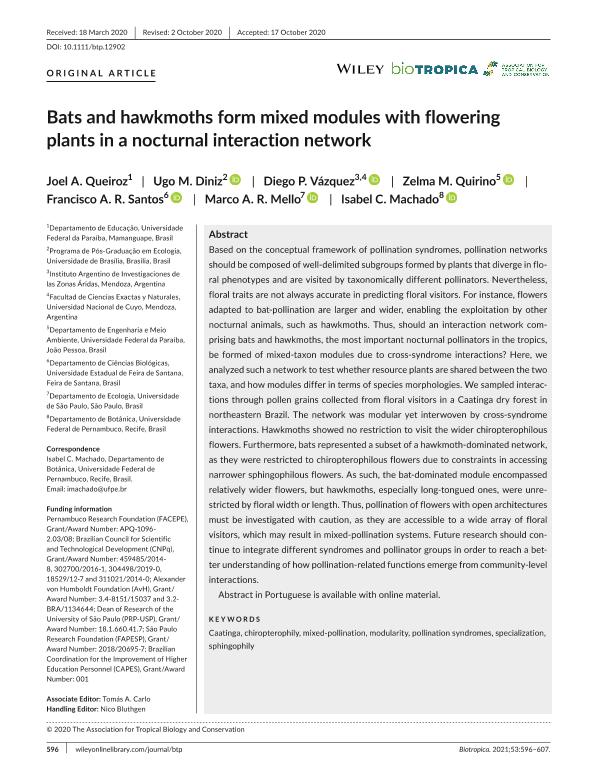Artículo
Bats and hawkmoths form mixed modules with flowering plants in a nocturnal interaction network
Queiroz, Joel A.; Diniz, Ugo M.; Vazquez, Diego P. ; Quirino, Zelma M.; Santos, Francisco A. R.; Mello, Marco A. R.; Machado, Isabel
; Quirino, Zelma M.; Santos, Francisco A. R.; Mello, Marco A. R.; Machado, Isabel
 ; Quirino, Zelma M.; Santos, Francisco A. R.; Mello, Marco A. R.; Machado, Isabel
; Quirino, Zelma M.; Santos, Francisco A. R.; Mello, Marco A. R.; Machado, Isabel
Fecha de publicación:
03/2021
Editorial:
Wiley Blackwell Publishing, Inc
Revista:
Biotropica
ISSN:
0006-3606
Idioma:
Inglés
Tipo de recurso:
Artículo publicado
Clasificación temática:
Resumen
Based on the conceptual framework of pollination syndromes, pollination networks should be composed of well-delimited subgroups formed by plants that diverge in floral phenotypes and are visited by taxonomically different pollinators. Nevertheless, floral traits are not always accurate in predicting floral visitors. For instance, flowers adapted to bat-pollination are larger and wider, enabling the exploitation by other nocturnal animals, such as hawkmoths. Thus, should an interaction network comprising bats and hawkmoths, the most important nocturnal pollinators in the tropics, be formed of mixed-taxon modules due to cross-syndrome interactions? Here, we analyzed such a network to test whether resource plants are shared between the two taxa, and how modules differ in terms of species morphologies. We sampled interactions through pollen grains collected from floral visitors in a Caatinga dry forest in northeastern Brazil. The network was modular yet interwoven by cross-syndrome interactions. Hawkmoths showed no restriction to visit the wider chiropterophilous flowers. Furthermore, bats represented a subset of a hawkmoth-dominated network, as they were restricted to chiropterophilous flowers due to constraints in accessing narrower sphingophilous flowers. As such, the bat-dominated module encompassed relatively wider flowers, but hawkmoths, especially long-tongued ones, were unrestricted by floral width or length. Thus, pollination of flowers with open architectures must be investigated with caution, as they are accessible to a wide array of floral visitors, which may result in mixed-pollination systems. Future research should continue to integrate different syndromes and pollinator groups in order to reach a better understanding of how pollination-related functions emerge from community-level interactions. Abstract in Portuguese is available with online material.
Archivos asociados
Licencia
Identificadores
Colecciones
Articulos(IADIZA)
Articulos de INST. ARG DE INVEST. DE LAS ZONAS ARIDAS
Articulos de INST. ARG DE INVEST. DE LAS ZONAS ARIDAS
Citación
Queiroz, Joel A.; Diniz, Ugo M.; Vazquez, Diego P.; Quirino, Zelma M.; Santos, Francisco A. R.; et al.; Bats and hawkmoths form mixed modules with flowering plants in a nocturnal interaction network; Wiley Blackwell Publishing, Inc; Biotropica; 53; 2; 3-2021; 596-607
Compartir
Altmétricas



